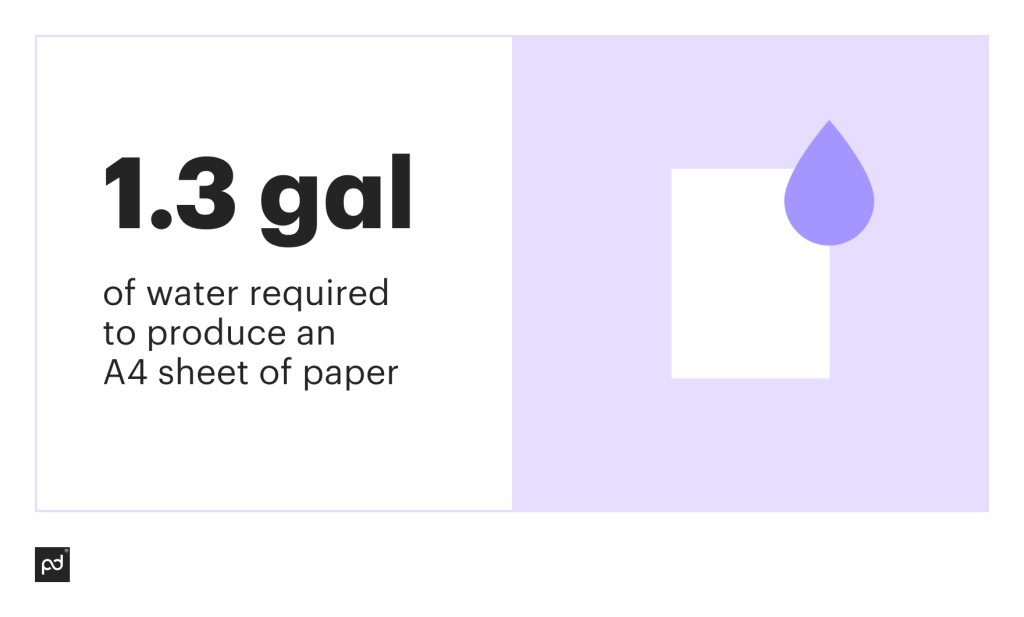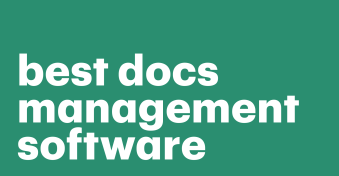With all the technological advances the human race has made over the years, you’d think that paper usage would have naturally decreased by now.
But this simply isn’t the case. The global volume of paper production has continued to rise and it reached a peak in 2021 when more than 417 million metric tons were produced.
It’s clear we don’t yet know how to reduce paper usage in the workplace.
So what can your business do to help win the war against the A4? We’re going to help teach you how to go paperless.
How to reduce paper waste in the office
The average office worker uses 10,000 sheets of paper each year, so reducing paper use in your office probably won’t happen overnight.
It’ll be a gradual process — death by a million (paper) cuts, if you will! The following, though, are good first steps to take when it comes to how to save paper:
1. Using document management software
One of the easiest ways to save paper (and money) is to sign up with a document management solution.
With a platform like PandaDoc, you and your team will find document generation and storage to be a breeze!
PandaDoc lets you create, upload, and edit any document for the entirety of its lifecycle. All documents can be stored locally or in the cloud.
These digital documents can be proposals, contracts, email templates, and anything else you may require.
This means any member of your company can access up-to-date documents for editing in real time.
This will allow you to reduce the amount of paper you use almost immediately. You’ll be working in a paperless workplace in no time!
Now you’re thinking to yourself: “We’ll still need to print off contracts and agreements that need to be signed”.
Actually, with a solution like PandaDoc, you can use legally-binding eSignatures. This feature streamlines contract signing and cuts out unnecessary print jobs.
2. Recycling office paper
Another thing you need to do is provide access to a recycling program through a waste company. However, there is more to it than just organizing a recycled paper system.
Sometimes we forget that the main purpose of recycling is to reduce waste by reusing materials.
So before you send off reams of used paper to the recycling bins, think about how you might still be able to use them yourself.
There are several effective ways to reuse office paper or make sure you need less of it:
Taking notes and memos
Whether in meetings, interviews, or doing research, notes don’t need to look pretty.
You can use the backs of previously printed documents for marking your note-taking “chicken scratches”, shorthand, or other barely legible writings.
While we’re at it, you might as well use any empty space on the printed sides of the paper, too.
Use email and communication apps
Keep written communication to digital channels so that less paper is handed out around the office.
Many team messaging apps will let you create separate channels for departments, events, projects, and any other bulletin board-type materials.
3. Duplex printing
We’ve talked about using both sides of a sheet of paper, and that doesn’t only apply to handwritten notes!
If you have duplex printers or copiers, you can set up a system for double-sided printing.
You can enable duplex printing in your system settings with Microsoft Windows or OSX.
This simple solution will help you reduce paper consumption when it comes to printing documents.
Alternatively, you can opt for manual duplex printing to reuse the same piece of paper.
With this feature turned on, you simply save all used paper in a neat stack, and then can reuse them for another round of printing.
4. Paperless billing
An easy way to eliminate paper is to stop other businesses from sending you bills, invoices, purchase orders, statements, and other accounting documents.
You’ll need to go into each account and sign up for paperless billing.
If you work with small companies or freelancers, you may just need to contact them and tell them of your efforts to reduce paper usage.
The good thing is that you’ll be able to seamlessly deposit all accounting documents into your paperless storage solution.
Team members will be able to access financial information at any time.
Not to mention that with paperless billing, you’ll be able to process and handle payments as soon as possible – no more having documents get “lost” in the mail.
Benefits of going paperless at work
Going paperless requires a bit of initial effort but it’s all worth it when you see the long-term payoffs:
Better document organization
Hard copies take up space.
Even if you have a perfect filing system and every team member’s desk is a modern minimalist piece of art, you still have to deal with an uncomfortable truth — you will always have more paper documents on the way.
At some point, you’re going to struggle to find the space to keep it all.
You can ignore the pesky limitations of physics by making the switch to virtual documents.
Even better, you can keep your files in one digital place where they can always be found by any member of your organization.
That means no more documents walking off from filing cabinets into unknown territories — as they’re often known to do somehow.
Effective backup and recovery
You can move on from having to print copies from document scanners for backups.
You may be realizing there are paperless apps you want for your business, like PandaDoc, where you won’t have to worry about losing documents.
The provider will have multiple data centers, so it’s nearly impossible for you not to have a digital copy available and on-screen when needed.
This is opposed to paper copies that can go missing or be destroyed permanently by fire or accidental shredding (d’oh!).
Even if you have a backup offsite storage facility, there will be some serious lag time to recover your documents.
Cut out unnecessary sheets of copy paper and back up your documents with a paperless system.
More eco-friendly
It’s long overdue for office sustainability to move to the forefront.
Between 33-40% of all wood paper goes to paper production. US offices are responsible for upwards of 12.1 million sheets of paper annually.
Paper production is one of the most energy-intensive industries out there today, and paper waste accounts for a quarter to one-third of all landfill waste.
The production process uses high volumes of water, with an A4 sheet of paper requiring 1.3 gallons of water.

Additionally, both paper production and waste produce huge amounts of CO2 emissions, furthering climate change.
Going paperless helps you do your part to save the planet — you’ll also be able to pull in more customer segments that share your conservation ethos!
Increased productivity
Document management platforms like PandaDoc help you work smarter.
The elimination of paper billing speeds up the payment process.
Important documents like legal contracts can be signed instantaneously upon generation with eSignatures.
Workflow automations also increase office productivity.
CRM data can be imported automatically.
This means your sales and customer service teams can have all up-to-date account data available from one space.
No wasting time looking through account binders — just run a query for a customer name, and bam!
Similarly, contracts, email templates, and much more can be found in seconds by any member of your team.
Reduced costs
Offices spend thousands of dollars every month, quarter, or year on paper alone.
When you add in printers, copiers, toner cartridges, and equipment maintenance, those costs start to really add up!
For a monthly fee, you can subscribe to a paperless management service like PandaDoc.
This lets you eliminate the monthly paper bills and ditch the printers outright.
Just think, if you can get rid of all that paper storage and equipment, you can probably downsize your office footprint.
Going paperless lets you cut down on materials, equipment, and space – which all points to a healthier bottom line.
Paper reduction also saves money by cutting out the labor that goes into printing, copying, and archiving documents.
With a paperless office environment, these activities are no longer required.
Improved security
Physical documents can be difficult to secure.
They often get misplaced and can be discovered by prying eyes. With document management software, you can rest assured that your important files are safe and secure.
Services like PandaDoc offer compliance with the SOC 2 industry standard.
All of your files are also backed by the AWS infrastructure for robust security and redundancy.
These types of services also give you document access control.
Administrators can set exactly who can view, edit, and download every document in your organization.
This means you can give access to the right people and no one else. Hackers will be unable to hijack your data.
Reduce paper usage in a significant way
As a global population, we’re falling more than short when it comes to waste management.
Businesses like yours can do their part by reducing paper use right now.
You’ve probably been thinking about taking action but are somewhat unsure how to get started.
We’ve given you some fast and easy tips to reduce your paper usage.
Get on the paperless fast track by signing up with a document management system like PandaDoc today!
Disclaimer
PandaDoc is not a law firm, or a substitute for an attorney or law firm. This page is not intended to and does not provide legal advice. Should you have legal questions on the validity of e-signatures or digital signatures and the enforceability thereof, please consult with an attorney or law firm. Use of PandaDocs services are governed by our Terms of Use and Privacy Policy.


